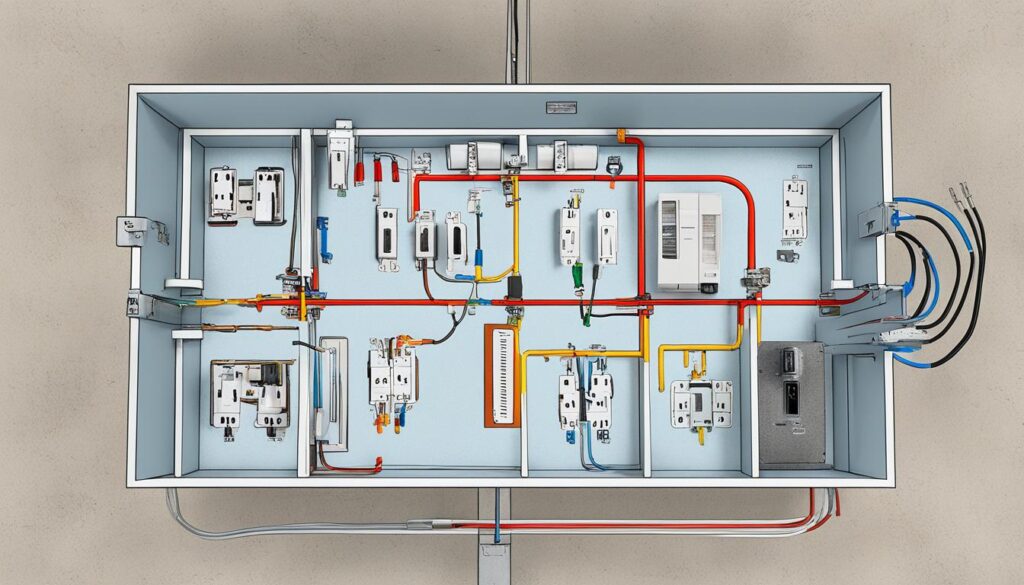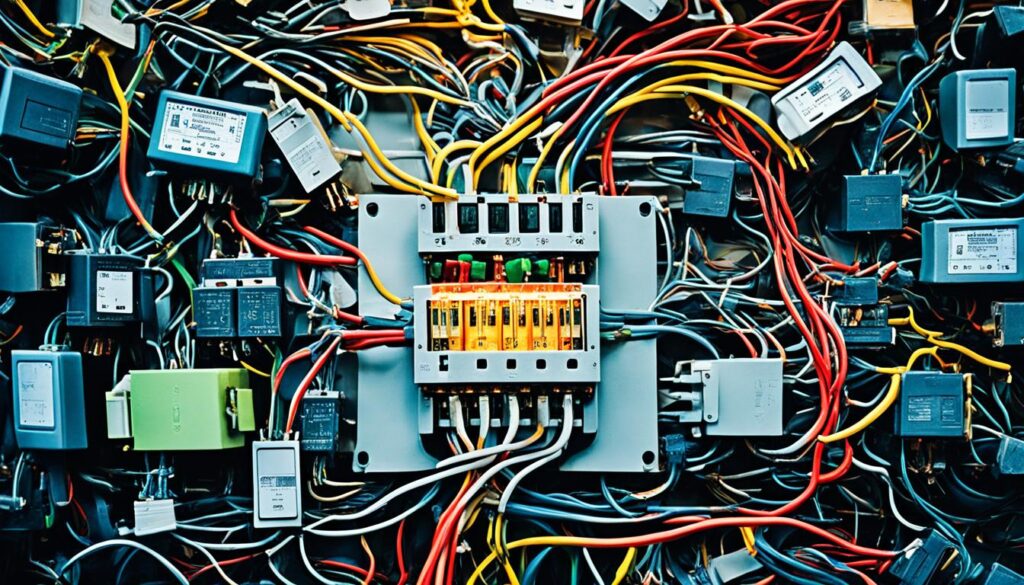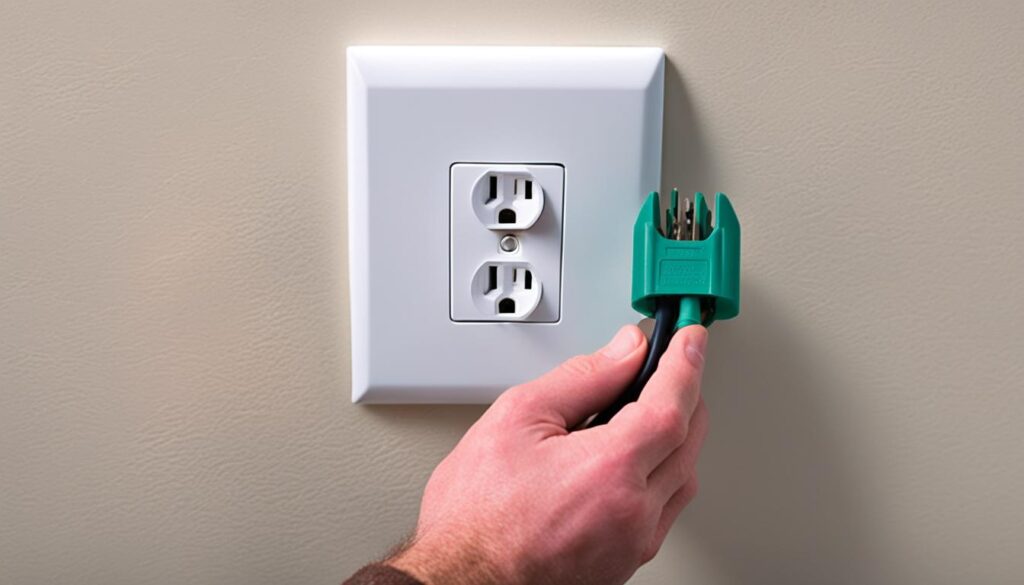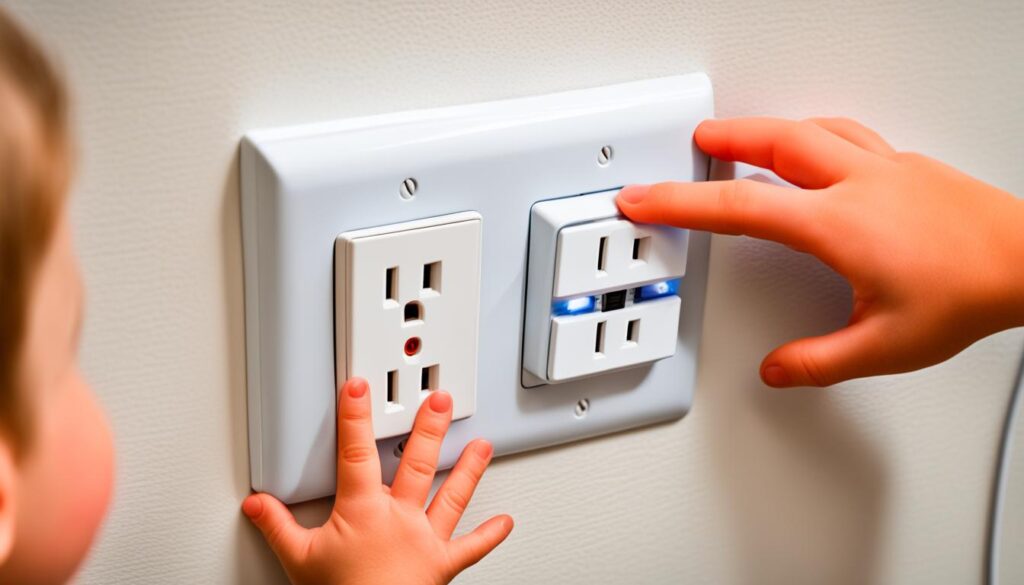According to the National Fire Protection Association, electrical failures or malfunctions were the second leading cause of electrical home fires, accounting for 13% of home structure fires. To ensure the safety of your home and reduce the risk of electrical fires and shock, it’s important to be mindful of your receptacle outlets. Here are some essential receptacle outlet safety tips to keep in mind:
Key Takeaways:
- Update your outlets to three-prong or ground fault circuit interrupter (GFCI) outlets for enhanced safety.
- Regularly inspect cords and covers for any damage and replace them as needed.
- Avoid overloading outlets by plugging major appliances into their dedicated wall outlets.
- Unplug cords safely by grabbing the base of the plug and pulling slowly.
- Childproof your outlets with plastic prong plugs to keep children safe.
Updating Your Outlets
One of the first steps to ensure electrical safety in your home is to update your outlets. If your home still has standard two-prong outlets, it’s time to replace them with three-prong or GFCI outlets. GFCI outlets provide an added layer of safety by cutting off power if they detect a hazard. Install GFCI outlets in areas prone to moisture, such as bathrooms, kitchens, garages, and basements. Make sure to follow proper installation and wiring guidelines when replacing outlets.

| Benefits of Upgrading Outlets | |
|---|---|
| Enhanced electrical safety | Reduced risk of electrical fires and shocks |
| Improved functionality | Ability to plug in three-prong devices |
| Added protection in moisture-prone areas | GFCI outlets cut off power in hazard situations |
| Compliance with electrical codes | Ensures your home meets safety standards |
Checking Cords and Covers
Regularly checking cords and covers is essential for maintaining electrical safety in your home. Ensuring that your cords and covers are in good condition can help prevent potential hazards and ensure the proper functioning of your outlets.
“Damaged cords and worn-out outlet covers can pose serious risks and should be addressed promptly.”
Inspecting Cords
It is important to inspect your cords regularly for any signs of damage, especially those with exposed wires. Frayed or damaged cords can lead to electrical shocks or fires. If you notice any of the following issues, **outlet repair** or replacement may be necessary:
- Exposed wires
- Cuts or deep scratches
- Loose or detached plugs
- Signs of overheating, such as discoloration or melting
If you come across any damaged cords, it is crucial to replace them immediately. Continuing to use damaged cords can put your home at risk. Be sure to use cords that are appropriate for the intended use and never overload them with too many devices.
Examining Outlet Covers
In addition to checking cords, it is equally important to regularly examine your outlet covers. Outlet covers help encase the wiring and provide a protective barrier against accidental contact. Here are some things to look out for when inspecting your outlet covers:
- Cracks or chips in the cover
- Loose or detached covers
- Hot or warm covers
- Burn marks or discoloration
- Buzzing or crackling noises
If you encounter any of these issues with your outlet covers, it is important to replace them or seek the assistance of a qualified electrician for **outlet repair**. Damaged or faulty outlet covers can increase the risk of electrical shocks, fires, and other electrical hazards.
| Common Issues | Actions |
|---|---|
| Cracked or chipped covers | Replace the cover with a new one. |
| Loose or detached covers | Tighten the screws or replace them if necessary. |
| Hot or warm covers | Turn off the power and contact a qualified electrician for inspection and **outlet repair**. |
| Burn marks or discoloration | Replace the cover and have the wiring inspected by a professional. |
| Buzzing or crackling noises | Turn off the power and consult an electrician to identify and resolve the issue. |
By regularly checking your cords and covers, you can take proactive steps towards ensuring the safety of your electrical system. Remember, if you encounter any issues or are unsure about performing **outlet repair** yourself, it is best to seek the assistance of a qualified electrician.
Avoiding Overload
Overloading an outlet can lead to power shutdowns or even electrical hazards. To ensure the safety of your electrical system, it’s important to prevent overloads by following these tips:
- Plug major appliances into their own dedicated wall outlets: When operating large appliances such as refrigerators, washers, or air conditioners, it is recommended to have them plugged into their own individual outlets. This prevents the strain on a single outlet and reduces the risk of an electrical overload.
- Be mindful of the number of appliances or devices plugged in: Before plugging in multiple devices or appliances, consider the electrical capacity of the outlet. It’s crucial to avoid exceeding the maximum load the outlet can handle. If you notice any flickering lights or frequent power shutdowns, it could be a sign of an overloaded outlet.
- Consider using energy-efficient light bulbs: Energy-efficient light bulbs consume less power compared to traditional incandescent bulbs. By using these bulbs throughout your home, you can reduce the overall electrical load and minimize the risk of overloading your outlets.
If you find that you frequently have more devices or appliances than your current outlets can handle, it may be necessary to consult with an electrician. They can assess your electrical system and install additional outlets in areas where they are needed most. This will distribute the electrical load more evenly and help prevent overloads.

Benefits of Preventing Electrical Overload
Preventing electrical overload in your home offers several benefits:
- Enhanced safety: By avoiding overloads, you minimize the risk of electrical hazards, such as short circuits or electrical fires.
- Increased reliability: When outlets are not overloaded, they perform more effectively and have longevity, preventing frequent power shutdowns.
- Improved energy efficiency: Using dedicated outlets for major appliances and energy-efficient light bulbs reduces energy consumption, leading to lower utility bills.
By following these guidelines and taking proactive measures to avoid electrical overload, you can ensure a safe and efficient electrical system in your home.
Safe Cord Unplugging
When it comes to electrical safety, cord removal requires careful attention to prevent any potential damage to both the cord and the outlet. Instead of tugging or wiggling a cord, it’s essential to adopt safe practices to ensure the longevity of your cords and outlets.
When it’s time to unplug a cord, avoid any abrupt movements. Instead, I recommend always grabbing the base of the plug firmly but gently and pulling it out slowly. This method helps to avoid any risks of broken wires, bent plugs, or damage to the outlet itself.
“By pulling the cord out gently, you significantly reduce the chances of outlet damage and potential short circuits.”
Remember, slow and steady wins the race! Taking a few extra seconds to unplug your cords properly can save you from costly repairs and ensure the continued safe operation of your electrical outlets.
What to Do if You Encounter Broken Wires or a Damaged Cord
If you notice any signs of a damaged cord, such as fraying or exposed wires, it’s crucial to address the issue promptly. Leaving a damaged cord in use can jeopardize your safety and increase the risk of electrical hazards.
If you identify a broken wire, I recommend taking the following steps:
- Stop using the cord immediately.
- Unplug the cord from the outlet.
- Securely wrap electrical tape around the damaged area to prevent further exposure of the wires.
- Consider seeking professional assistance or contacting a qualified electrician to assess the damage and recommend appropriate repairs or replacements.
Remember, safety should always be your top priority. Taking immediate action to address any cord damage can prevent accidents and ensure the overall integrity of your electrical system.

Childproofing Outlets
Child safety is of utmost importance when it comes to electrical outlets. Young children are naturally curious and outlets, being at eye level, can be quite enticing to them. To prevent any accidents or injuries, it is crucial to take measures to childproof your outlets.
One effective way to childproof outlets is by using plastic prong plugs. These plugs are specifically designed to cover outlets, making them inaccessible to children. The plugs fit securely inside the outlet, creating a barrier that prevents children from inserting objects or their fingers into the socket.
Plastic prong plugs are easy to install and remove. Adults can easily insert and remove the plugs when needed, ensuring the safety of the outlet when not in use. They are also durable and long-lasting, providing a reliable solution for outlet protection.
If you have multiple outlets in your home, it’s recommended to buy plastic prong plugs in bulk. This not only ensures that you have enough plugs to cover all the outlets but also offers cost savings compared to buying individual plugs.
Child safety is a top priority when it comes to electrical outlets. Using plastic prong plugs is a simple and effective way to childproof your outlets, preventing any potential accidents or injuries.
Benefits of Plastic Prong Plugs for Outlet Protection:
- Easy to install and remove
- Secure fit for enhanced safety
- Durable and long-lasting
- Cost-effective when bought in bulk
How to Install Plastic Prong Plugs:
- Ensure the outlet is switched off or has no power.
- Take a plastic prong plug and insert the prongs into the sockets of the outlet.
- Ensure the plug fits securely and covers the entire outlet.
- Repeat the process for all the outlets you wish to childproof.
By taking the necessary steps to childproof your outlets with plastic prong plugs, you can have peace of mind knowing that your little ones are safe from any electrical hazards. Remember, it’s always better to be proactive and prevent accidents before they happen.

Conclusion
Ensuring the safety of your home’s electrical system is paramount. By following these receptacle outlet tips, you can significantly reduce the risk of electrical fires and injuries. It’s crucial to update your outlets to three-prong or ground fault circuit interrupter (GFCI) outlets to enhance electrical safety. Regularly checking cords and covers for damage or wear and tear is equally important to maintain outlet maintenance.
Another essential measure is to avoid overloading outlets by plugging major appliances into their own dedicated wall outlets. This helps you prevent electrical overload and potential hazards. Safely unplugging cords by gripping the base of the plug and pulling slowly helps prevent damage to the cord, outlet damage, and broken wires.
Moreover, childproofing outlets is crucial to keep your little ones safe. By using plastic prong plugs to cover outlets, you can prevent access to electrical outlets, reducing the risk of accidents and ensuring home wiring safety. Remember, if you have any concerns or encounter electrical issues, it’s always wise to consult a qualified electrician.

